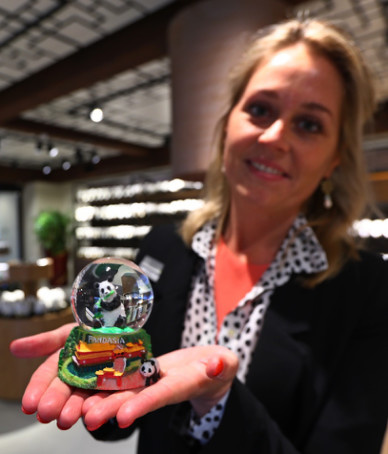By Gong Ming from People’s Daily

Finnish people’s dreams to see Chinese giant pandas in their own country have finally come true after China agreed to send a pair of pandas to Finland during Chinese President Xi Jinping’s state visit on Wednesday.
The public in the European country of all ages are enthusiastic for China’s cute giant pandas. Xi’s Finnish trip this time brought such passion to an unprecedented high. A poll before Xi’s visit showed that bringing giant pandas to Finland is what local residents expect most of the president’s trip.
Their dream has come true after a memorandum of understanding to jointly research on giant panda was inked between China's State Forestry Administration and its Finnish counterpart in Helsinki on Wednesday.
According to the memorandum, China will send two pandas to Finland for the research on giant pandas, which will be jointly carried out by China Wildlife Conservation Association (CWCA) and the Ähtari Zoo in Finland. The cute animals will be loaned for 15 years.
Finland will pay a designated amount of fund to China, which will be used to build up the scientific research of giant pandas, protection of breeding base, conservation, management and other purposes, according to the agreement.
According to Li Qingwen, the deputy secretary-general of CWCA, experts of both countries started their investigations and discussions about which zoo should host the pandas since 2014.
Ähtari Zoo was chosen because it is the biggest nature reserve in Finland, and it shares similar climate with the panda bases in Sichuan of southwest China, Li explained.
The Ähtari Zoo has a total area of over 5,000 square meters and can provide an environment close to wildlife habitation for the pandas. In addition, the zoo is reliable in terms of disease treatment, rescue and epidemic disease research, because it has close ties with the Veterinary Hospital of University of Helsinki.
By the end of 2016, China has developed research projects on giant pandas with 18 zoos from 13 countries, including the US, Austria, Thailand, Spain, Australia, the UK and France. Currently, there are a total of 53 giant pandas and panda cubs living overseas, Li said.
Giant panda, China's unofficial national mascot, has been regarded as a bond to enhance connections and a token of peace and friendship.
In 1961, a giant panda Chi Chi caused a stir in London when it arrived in the city for exhibition. The World Wide Fund for Nature (WWF) decided to use the panda to design its logo, considering that the passion for life can cross language barriers.
The adorable giant pandas could always ignite people’s enthusiasm wherever they go. At the end of 2011, China rent two giant pandas Tian Tian (Sweetie) and Sunshine to the Edinburgh Zoo in Scotland. Later that year, Tian Tian was voted as the December Woman 2011.
The two pandas also aroused the interest to learn Chinese culture and characters among the Scottish, who even hosted events to welcome the traditional Chinese Spring Festival. After the arrivals of the two pandas, the Edinburgh Zoo started to make profits with the annual revenue rising from £ 5 million to £15 million and visitor number increasing by 51 percent.
After two years’ dialogues between China and France, giant pandas Huan Huan and Yuan Zai arrived in France in 2012. The hosting Beauval Zoo has become the top tourist destination in the province of Loir-et-Cher thanks to the two pandas. According to statistics, over 1 million tourists visited the zoo in the same year, up 60 percent from the previous year.
The giant pandas are not just attractions. The purpose of international cooperation on panda research is not only to breed the animals and display them in the partnership countries, but also to better protect them and other endangered species by scientific research and raising public awareness via publicity, Li said.
With such efforts, overseas giant pandas are having productive success. In June 2016, panda Hao Hao gave birth to a male cub at Paira Daiza zoo in Belgium.
Later that year, mother Yang Yang and father Long Hui gave birth to twins in Vienna Zoo. The panda couple has given birth to 5 cubs since they came to Vienna. Often pandas can only be bred by zoos using artificial insemination, which makes the twins - conceived naturally - a special and rare case in Europe.
Thanks to unremitting protection by China for the past over 10 years, the International Union for Conservation of Nature (IUCN) announced in September 2016 that the giant pandas were downgraded from ‘Endangered’ to ‘Vulnerable’ on the global list of species at risk of extinction.
The organization also estimated the total population of wild giant pandas, including the cubs, at 2,060.
Pic:
A staff demonstrates a giant panda souvenir at a shop affiliated to the Ouwehands Dierenpark in Rhenen in the Netherlands, April 5, 2017. Chinese pandas will arrive in the country on April 12. (Xinhua/Gong Bing)
The public in the European country of all ages are enthusiastic for China’s cute giant pandas. Xi’s Finnish trip this time brought such passion to an unprecedented high. A poll before Xi’s visit showed that bringing giant pandas to Finland is what local residents expect most of the president’s trip.
Their dream has come true after a memorandum of understanding to jointly research on giant panda was inked between China's State Forestry Administration and its Finnish counterpart in Helsinki on Wednesday.
According to the memorandum, China will send two pandas to Finland for the research on giant pandas, which will be jointly carried out by China Wildlife Conservation Association (CWCA) and the Ähtari Zoo in Finland. The cute animals will be loaned for 15 years.
Finland will pay a designated amount of fund to China, which will be used to build up the scientific research of giant pandas, protection of breeding base, conservation, management and other purposes, according to the agreement.
According to Li Qingwen, the deputy secretary-general of CWCA, experts of both countries started their investigations and discussions about which zoo should host the pandas since 2014.
Ähtari Zoo was chosen because it is the biggest nature reserve in Finland, and it shares similar climate with the panda bases in Sichuan of southwest China, Li explained.
The Ähtari Zoo has a total area of over 5,000 square meters and can provide an environment close to wildlife habitation for the pandas. In addition, the zoo is reliable in terms of disease treatment, rescue and epidemic disease research, because it has close ties with the Veterinary Hospital of University of Helsinki.
By the end of 2016, China has developed research projects on giant pandas with 18 zoos from 13 countries, including the US, Austria, Thailand, Spain, Australia, the UK and France. Currently, there are a total of 53 giant pandas and panda cubs living overseas, Li said.
Giant panda, China's unofficial national mascot, has been regarded as a bond to enhance connections and a token of peace and friendship.
In 1961, a giant panda Chi Chi caused a stir in London when it arrived in the city for exhibition. The World Wide Fund for Nature (WWF) decided to use the panda to design its logo, considering that the passion for life can cross language barriers.
The adorable giant pandas could always ignite people’s enthusiasm wherever they go. At the end of 2011, China rent two giant pandas Tian Tian (Sweetie) and Sunshine to the Edinburgh Zoo in Scotland. Later that year, Tian Tian was voted as the December Woman 2011.
The two pandas also aroused the interest to learn Chinese culture and characters among the Scottish, who even hosted events to welcome the traditional Chinese Spring Festival. After the arrivals of the two pandas, the Edinburgh Zoo started to make profits with the annual revenue rising from £ 5 million to £15 million and visitor number increasing by 51 percent.
After two years’ dialogues between China and France, giant pandas Huan Huan and Yuan Zai arrived in France in 2012. The hosting Beauval Zoo has become the top tourist destination in the province of Loir-et-Cher thanks to the two pandas. According to statistics, over 1 million tourists visited the zoo in the same year, up 60 percent from the previous year.
The giant pandas are not just attractions. The purpose of international cooperation on panda research is not only to breed the animals and display them in the partnership countries, but also to better protect them and other endangered species by scientific research and raising public awareness via publicity, Li said.
With such efforts, overseas giant pandas are having productive success. In June 2016, panda Hao Hao gave birth to a male cub at Paira Daiza zoo in Belgium.
Later that year, mother Yang Yang and father Long Hui gave birth to twins in Vienna Zoo. The panda couple has given birth to 5 cubs since they came to Vienna. Often pandas can only be bred by zoos using artificial insemination, which makes the twins - conceived naturally - a special and rare case in Europe.
Thanks to unremitting protection by China for the past over 10 years, the International Union for Conservation of Nature (IUCN) announced in September 2016 that the giant pandas were downgraded from ‘Endangered’ to ‘Vulnerable’ on the global list of species at risk of extinction.
The organization also estimated the total population of wild giant pandas, including the cubs, at 2,060.
Pic:
A staff demonstrates a giant panda souvenir at a shop affiliated to the Ouwehands Dierenpark in Rhenen in the Netherlands, April 5, 2017. Chinese pandas will arrive in the country on April 12. (Xinhua/Gong Bing)
 Menu
Menu
 Giant pandas to tighten China-Finland bond
Giant pandas to tighten China-Finland bond
















